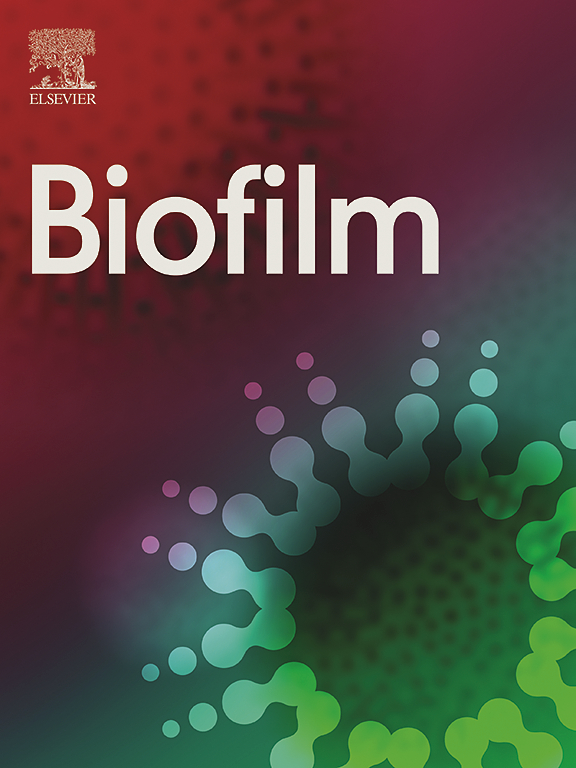Relationship between capsule production and biofilm formation by Mannheimia haemolytica, and establishment of a poly-species biofilm with other Pasteurellaceae
IF 4.9
Q1 MICROBIOLOGY
引用次数: 0
Abstract
Mannheimia haemolytica is one of the bacterial agents responsible for bovine respiratory disease (BRD). The capability of M. haemolytica to form a biofilm may contribute to the development of chronic BRD infection by making the bacteria more resistant to host innate immunity and antibiotics. To improve therapy and prevent BRD, a greater understanding of the association between M. haemolytica surface components and biofilm formation is needed. M. haemolytica strain 619 (wild-type) made a poorly adherent, low-biomass biofilm. To examine the relationship between capsule and biofilm formation, a capsule-deficient mutant of wild-type M. haemolytica was obtained following mutagenesis with ethyl methanesulfonate to obtain mutant E09. Loss of capsular polysaccharide (CPS) in mutant E09 was supported by transmission electron microscopy and Maneval's staining. Mutant E09 attached to polyvinyl chloride plates more effectively, and produced a significantly denser and more uniform biofilm than the wild-type, as determined by crystal violet staining, scanning electron microscopy, and confocal laser scanning microscopy with COMSTAT analysis. The biofilm matrix of E09 contained predominately protein and significantly more eDNA than the wild-type, but not a distinct exopolysaccharide. Furthermore, treatment with DNase I significantly reduced the biofilm content of both the wild-type and E09 mutant. DNA sequencing of E09 showed that a point mutation occurred in the capsule biosynthesis gene wecB. The complementation of wecB in trans in mutant E09 successfully restored CPS production and reduced bacterial attachment/biofilm to levels similar to that of the wild-type. Fluorescence in-situ hybridization microscopy showed that M. haemolytica formed a poly-microbial biofilm with Histophilus somni and Pasteurella multocida. Overall, CPS production by M. haemolytica was inversely correlated with biofilm formation, the integrity of which required eDNA. A poly-microbial biofilm was readily formed between M. haemolytica, H. somni, and P. multocida, suggesting a mutualistic or synergistic interaction that may benefit bacterial colonization of the bovine respiratory tract.
溶血曼氏菌产生胶囊与形成生物膜之间的关系,以及与其他巴斯德氏菌建立多菌种生物膜的情况
溶血曼氏菌是导致牛呼吸道疾病(BRD)的细菌病原体之一。溶血曼氏菌形成生物膜的能力可能会使细菌对宿主的先天免疫和抗生素产生更强的抵抗力,从而导致慢性牛呼吸道疾病感染的发生。为了改善治疗和预防 BRD,需要进一步了解溶血曼氏菌表面成分与生物膜形成之间的关系。溶血霉菌 619 株(野生型)形成的生物膜粘附性差、生物量低。为了研究胶囊与生物膜形成之间的关系,用甲磺酸乙酯诱变野生型溶血甲藻,得到了一个胶囊缺乏的突变体 E09。透射电子显微镜和 Maneval 染色法证实了突变体 E09 胶囊多糖(CPS)的缺失。与野生型相比,突变体 E09 能更有效地附着在聚氯乙烯板上,并产生密度更大、更均匀的生物膜,这是由水晶紫染色、扫描电子显微镜和共聚焦激光扫描显微镜以及 COMSTAT 分析确定的。E09 的生物膜基质主要含有蛋白质,其 eDNA 含量明显高于野生型,但没有明显的外多糖。此外,用 DNase I 处理可显著减少野生型和 E09 突变体的生物膜含量。E09 的 DNA 测序表明,胶囊生物合成基因 wecB 发生了点突变。在突变体 E09 中对 wecB 进行反式互补,成功地恢复了 CPS 的产生,并将细菌附着/生物膜减少到与野生型相似的水平。荧光原位杂交显微镜显示,溶血单胞菌与嗜组织胞浆菌(Histophilus somni)和多杀性巴氏杆菌(Pasteurella multocida)形成了多微生物生物膜。总体而言,溶血霉菌产生的 CPS 与生物膜的形成成反比,而生物膜的完整性需要 eDNA。溶血霉菌、嗜组织胞浆菌和多杀性巴氏杆菌之间很容易形成多微生物生物膜,这表明它们之间存在互利或协同作用,可能有利于细菌在牛呼吸道的定植。
本文章由计算机程序翻译,如有差异,请以英文原文为准。
求助全文
约1分钟内获得全文
求助全文

 求助内容:
求助内容: 应助结果提醒方式:
应助结果提醒方式:


